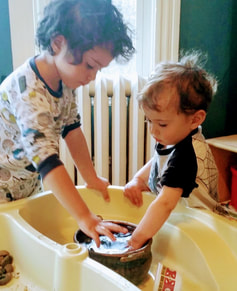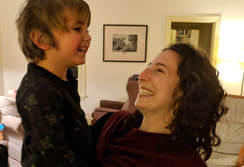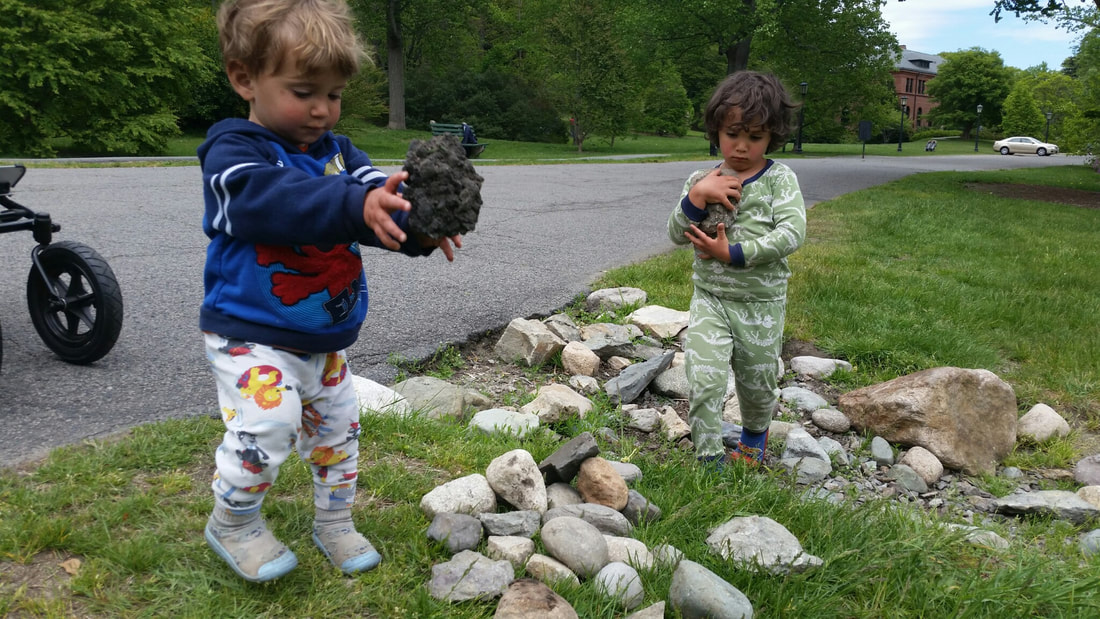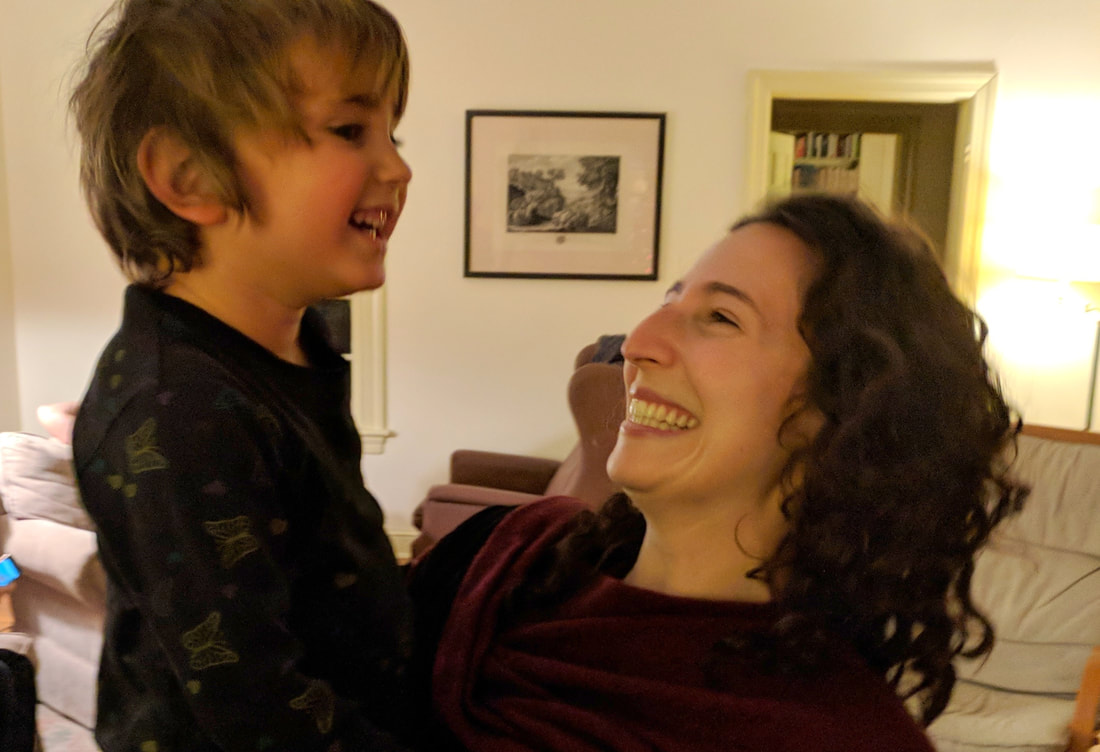
Do kids always have to share?
A reader on Facebook responded to my last blog post asking if I always expect my children to share. My quick response was, “Heck no!” As I continued to reflect on the sharing question, I decided I wanted to offer a few thoughts to help contextualize the story from that post. Today's article also includes nine ways adults might respond helpfully to a sibling quarrel in which the baby or young toddler wants the toy the big kid is using.
First of all, Darwin’s initial actions were age appropriate ways to say he was not ready to give up or share this toy with his brother: covering it with his body and then later putting it out of Forest’s reach. In fact, these ways of expressing his desires were relatively considerate of Forest’s feelings when compared to some other typical three year old actions, like hitting, kicking, biting, or screaming. I wish I could go back in time and whisper this big picture view to my earlier self so that I could feel more appreciative and empathetic to Darwin the three year old!
Second, though it’s true that when this story took place I felt very disappointed in Darwin’s resistance to sharing with his brother, I already believed intellectually that sharing or giving up of a toy should not be forced by an adult. Now, years later, I feel even more strongly that a good home rule is that whoever is using something should get to keep using it until she feels done, because the typical ways adults enforce sharing teach kids that (1) sharing feels bad because it’s something others make you do, (2) big people are the resolvers and deciders, and (3) my desire to pay attention to something that I find fascinating is not as important as giving others what they want when they demand it.
On the other hand, empowering children to decide when they’re ready to share teaches (1) I know how to be generous when I’m ready, (2) my intellectual curiosity is important, and (3) sometimes it’s hard to wait for something I want, but I can do it and my grownup will help me get better at waiting. Check out Heather Shumaker and Laura Markham for more on why you can stop making your kids share when you think they’re supposed to.
9 Tips for When the Baby/Toddler Wants the Big Kid’s Toy
How can you help when a 13 month old wants a toy that his three year old brother is currently using, and the three year old is working hard to keep the toy away from the baby? Here are nine good options.
1. Emphatically acknowledge both children’s feelings.
“Darwin, you are using those stacking blocks right now. Are you feeling like you’re NOT ready for Forest to use any of them?”
“Forest, you really want those blocks!”
Identifying children’s feelings is a good default strategy for mediating conflicts because it helps each person feel heard and appreciate each other's point of view, thus freeing them up to move the process forward. Sometimes one acknowledgment per child is enough for them to figure out the next move.
2. Help them see the problem and ask them to help solve it.
Sometimes, though you successfully acknowledge each child’s perspective several times, they remain stuck. In this situation, you can show respect for their struggle, summarize, and then ask them to solve the problem.
“This is a hard problem. Darwin, you are using the blocks right now and are not ready to share. Forest, you really want to play with the blocks. What do we do in a case like this?”
You can also try skipping the discussion of feelings and perspectives, and simply state the facts of the problem and request a solution, as in, "I see two kids and one set of 8 blocks. What do we do in a case like this?" Ideas such as splitting the blocks, taking turns, or using them together might come up. If the kids aren’t able to stop engaging with the toy during the conversation, you can firmly immobilize (but not take!) the object while you problem solve.
3. Get on the floor and involve both children in a more complex game.
“Can I help you build Darwin? We can pretend we’re building a big tower and a silly dinosaur is always trying to knock it down, but we have to build it up again before he knocks it again. Forest, can you be the silly dinosaur and knock down the tower?”
4. Playfully join in the fight.
One productive way to transform a sibling conflict is to playfully pit the kids against the grownups. “Hey!” I could say with wide eyes and a big smile. “Those are the most beautiful blocks I’ve ever seen and I want them right now!” Darwin would say, “No!” to me, and I would feign a terrible upset. “What?! Grownups aren’t allowed to use them?” Another opportunity for Darwin to say “No!” probably with a big giggle. “Just kids?! That’s no fair!! You and Forest both get to use them and I don’t!” At this point, it’s likely that Darwin would start offering parts of the blocks to Forest as a way to get me more “upset” while I fall apart in a pretend and very exaggerated tantrum on the floor. Both kids would be laughing with each other as well as feeling connected to me.
5. Coach the older child in the moment.
“Darwin, can you find another toy you think Forest would like?”
6. Playfully practice the toy offer strategy with the older child when the baby/toddler is not around.
“Darwin, let’s pretend I’m Forest and I start grabbing for the purple dinosaur you’re holding.” Playing with a parent about the situation can help relieve stress about it while at the same time teaching an effective strategy. Darwin and I once played this game for half an hour while Forest napped. He thought it was hilarious when I toddled, grabbed, and cried like Forest, and he became a master at finding toys for me that would distract me from my desire for the purple dinosaur.
7. Protect a child’s right to continue playing with a toy, then engage the other child in a new activity.
Sit close to both children, wrapping Forest in a loving hug that also keeps him from grabbing the blocks. “Forest, let’s ask Darwin. Darwin, can Forest use some of the blocks?”
“No.”
“When can he use them?”
“When I’m done.”
“Okay, can you please give them to him when you’re done?”
“Okay.”
“Come on Forest, let’s go find your green ball!”
With verbal children who don’t have the words for this exchange, you can give them the words they need:
To the child without the object: “You can say, ‘When can I use it?’"
To the child with the object: “You can say, ‘When I'm done.’”
8. Help the disappointed child with his feelings.
It’s possible the offer of a new activity would distract Forest, but if it doesn’t, I believe it is still important in almost all cases to protect the right of the other child to continue using a toy he is engaged with. So if Forest’s response is to screech and frantically reach again for the desired toy, I could lovingly hold him back from Darwin. Lots of acknowledging his feelings and listening to his upset would be necessary here. “Oh Forest, you want those blocks so much. It is so hard to wait! I am here for you, and I will help you wait.”
And if he keeps on crying, I can confidently and firmly keep him from the blocks, offering lots of hugs and eye contact. As he cries, I continue to listen empathically, perhaps in silence, perhaps with periodic murmurings like, “I know…It’s hard…I love you…” And when he's let out his feelings and calmed down some, I can tell the story for him again and then offer a distraction again. “Darwin was playing with the blocks and you wanted them, and it is so hard to wait. You will get to use them later. Do you want to help me make a smoothie for our snack?”
9. Describe and give space.
Take a look at my last post for a detailed description of this strategy, also called sportscasting by Janet Lansbury. I love describe and give space because when all you do is verbalize the facts, you don’t have to know what’s right and wrong in a given situation. As confident as we sometimes can be, the truth is that adults often have a limited view of children’s relational conflicts, as I did three years ago when my inclination in the heat of the moment was to sympathize with Forest and feel frustrated with Darwin. What good fortune, from three year old Darwin’s perspective, that I didn’t try to exert more influence in their conflict, since I would probably have ended up shaming him for his perfectly normal three year old behavior. So I often head for describe and give space when I don’t understand what’s driving the conflict between my kids, or when other interventions seem not to take hold.
By keeping my opinions out their conflict, but staying present by describing my observations, sharing my feelings, and modeling how I worked with my feelings, Darwin learned:
With joy,
Cynthia
A reader on Facebook responded to my last blog post asking if I always expect my children to share. My quick response was, “Heck no!” As I continued to reflect on the sharing question, I decided I wanted to offer a few thoughts to help contextualize the story from that post. Today's article also includes nine ways adults might respond helpfully to a sibling quarrel in which the baby or young toddler wants the toy the big kid is using.
First of all, Darwin’s initial actions were age appropriate ways to say he was not ready to give up or share this toy with his brother: covering it with his body and then later putting it out of Forest’s reach. In fact, these ways of expressing his desires were relatively considerate of Forest’s feelings when compared to some other typical three year old actions, like hitting, kicking, biting, or screaming. I wish I could go back in time and whisper this big picture view to my earlier self so that I could feel more appreciative and empathetic to Darwin the three year old!
Second, though it’s true that when this story took place I felt very disappointed in Darwin’s resistance to sharing with his brother, I already believed intellectually that sharing or giving up of a toy should not be forced by an adult. Now, years later, I feel even more strongly that a good home rule is that whoever is using something should get to keep using it until she feels done, because the typical ways adults enforce sharing teach kids that (1) sharing feels bad because it’s something others make you do, (2) big people are the resolvers and deciders, and (3) my desire to pay attention to something that I find fascinating is not as important as giving others what they want when they demand it.
On the other hand, empowering children to decide when they’re ready to share teaches (1) I know how to be generous when I’m ready, (2) my intellectual curiosity is important, and (3) sometimes it’s hard to wait for something I want, but I can do it and my grownup will help me get better at waiting. Check out Heather Shumaker and Laura Markham for more on why you can stop making your kids share when you think they’re supposed to.
9 Tips for When the Baby/Toddler Wants the Big Kid’s Toy
How can you help when a 13 month old wants a toy that his three year old brother is currently using, and the three year old is working hard to keep the toy away from the baby? Here are nine good options.
1. Emphatically acknowledge both children’s feelings.
“Darwin, you are using those stacking blocks right now. Are you feeling like you’re NOT ready for Forest to use any of them?”
“Forest, you really want those blocks!”
Identifying children’s feelings is a good default strategy for mediating conflicts because it helps each person feel heard and appreciate each other's point of view, thus freeing them up to move the process forward. Sometimes one acknowledgment per child is enough for them to figure out the next move.
2. Help them see the problem and ask them to help solve it.
Sometimes, though you successfully acknowledge each child’s perspective several times, they remain stuck. In this situation, you can show respect for their struggle, summarize, and then ask them to solve the problem.
“This is a hard problem. Darwin, you are using the blocks right now and are not ready to share. Forest, you really want to play with the blocks. What do we do in a case like this?”
You can also try skipping the discussion of feelings and perspectives, and simply state the facts of the problem and request a solution, as in, "I see two kids and one set of 8 blocks. What do we do in a case like this?" Ideas such as splitting the blocks, taking turns, or using them together might come up. If the kids aren’t able to stop engaging with the toy during the conversation, you can firmly immobilize (but not take!) the object while you problem solve.
3. Get on the floor and involve both children in a more complex game.
“Can I help you build Darwin? We can pretend we’re building a big tower and a silly dinosaur is always trying to knock it down, but we have to build it up again before he knocks it again. Forest, can you be the silly dinosaur and knock down the tower?”
4. Playfully join in the fight.
One productive way to transform a sibling conflict is to playfully pit the kids against the grownups. “Hey!” I could say with wide eyes and a big smile. “Those are the most beautiful blocks I’ve ever seen and I want them right now!” Darwin would say, “No!” to me, and I would feign a terrible upset. “What?! Grownups aren’t allowed to use them?” Another opportunity for Darwin to say “No!” probably with a big giggle. “Just kids?! That’s no fair!! You and Forest both get to use them and I don’t!” At this point, it’s likely that Darwin would start offering parts of the blocks to Forest as a way to get me more “upset” while I fall apart in a pretend and very exaggerated tantrum on the floor. Both kids would be laughing with each other as well as feeling connected to me.
5. Coach the older child in the moment.
“Darwin, can you find another toy you think Forest would like?”
6. Playfully practice the toy offer strategy with the older child when the baby/toddler is not around.
“Darwin, let’s pretend I’m Forest and I start grabbing for the purple dinosaur you’re holding.” Playing with a parent about the situation can help relieve stress about it while at the same time teaching an effective strategy. Darwin and I once played this game for half an hour while Forest napped. He thought it was hilarious when I toddled, grabbed, and cried like Forest, and he became a master at finding toys for me that would distract me from my desire for the purple dinosaur.
7. Protect a child’s right to continue playing with a toy, then engage the other child in a new activity.
Sit close to both children, wrapping Forest in a loving hug that also keeps him from grabbing the blocks. “Forest, let’s ask Darwin. Darwin, can Forest use some of the blocks?”
“No.”
“When can he use them?”
“When I’m done.”
“Okay, can you please give them to him when you’re done?”
“Okay.”
“Come on Forest, let’s go find your green ball!”
With verbal children who don’t have the words for this exchange, you can give them the words they need:
To the child without the object: “You can say, ‘When can I use it?’"
To the child with the object: “You can say, ‘When I'm done.’”
8. Help the disappointed child with his feelings.
It’s possible the offer of a new activity would distract Forest, but if it doesn’t, I believe it is still important in almost all cases to protect the right of the other child to continue using a toy he is engaged with. So if Forest’s response is to screech and frantically reach again for the desired toy, I could lovingly hold him back from Darwin. Lots of acknowledging his feelings and listening to his upset would be necessary here. “Oh Forest, you want those blocks so much. It is so hard to wait! I am here for you, and I will help you wait.”
And if he keeps on crying, I can confidently and firmly keep him from the blocks, offering lots of hugs and eye contact. As he cries, I continue to listen empathically, perhaps in silence, perhaps with periodic murmurings like, “I know…It’s hard…I love you…” And when he's let out his feelings and calmed down some, I can tell the story for him again and then offer a distraction again. “Darwin was playing with the blocks and you wanted them, and it is so hard to wait. You will get to use them later. Do you want to help me make a smoothie for our snack?”
9. Describe and give space.
Take a look at my last post for a detailed description of this strategy, also called sportscasting by Janet Lansbury. I love describe and give space because when all you do is verbalize the facts, you don’t have to know what’s right and wrong in a given situation. As confident as we sometimes can be, the truth is that adults often have a limited view of children’s relational conflicts, as I did three years ago when my inclination in the heat of the moment was to sympathize with Forest and feel frustrated with Darwin. What good fortune, from three year old Darwin’s perspective, that I didn’t try to exert more influence in their conflict, since I would probably have ended up shaming him for his perfectly normal three year old behavior. So I often head for describe and give space when I don’t understand what’s driving the conflict between my kids, or when other interventions seem not to take hold.
By keeping my opinions out their conflict, but staying present by describing my observations, sharing my feelings, and modeling how I worked with my feelings, Darwin learned:
- My mother has confidence that I can figure out how to navigate a social conflict, and it’s okay for me to try my own strategies.
- Even though I was in charge of handling this conflict, my mother didn’t leave me totally on my own. She was there for me when I needed help from her.
- My brother was upset at first when I hid the toys from him, and that wasn’t fun.
- My mother was also upset when my brother was upset because she cares about all her children, but she did not get mad at me or think I’m a bad brother or a mean person.
- When I was ready to reconnect with my brother, I knew how to do it. He felt better and my mother also felt better. That also felt good to me.
- Even my mother feels upset sometimes, and when she does, she counts and breathes to help herself get calm again, and that also makes it easier for her to help me.
With joy,
Cynthia

Looking to expand your parenting tool box in a supportive, small group setting? Do you want to raise your children with more confidence, connection, and fun? Both of my eight week series, How to Talk So Kids Will Listen and Siblings Without Rivalry, will give you the skills and inspiration you need to be more effective with your children and more helpful to yourself.


